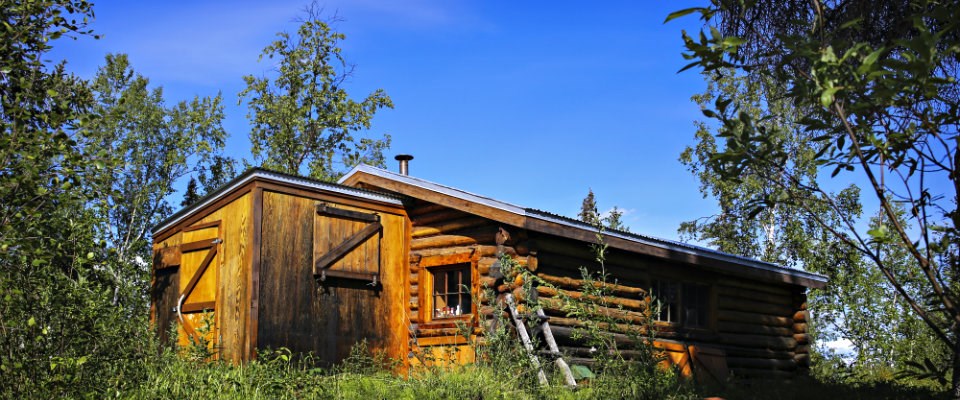
NPS Photo/Emily Mesner The story of Arctic archeology is dominated by one towering figure – J. Louis Giddings. A tall, soft-spoken man, he was nevertheless one of the loudest and most respected voices in his field. During his twenty-five years of fieldwork in Northwest Alaska, Giddings worked on five major excavations. He was instrumental in the identification of several previously unexplored cultures and the discovery of many of the most important sites in Arctic archeology. His work at the Cape Krusenstern beach ridges and Onion Portage formed the basis of the modern understanding of the human history in Arctic Alaska. Although he arrived in Northwest Alaska thousands of years after its first inhabitants, he is an instrumental part in the telling of their story. 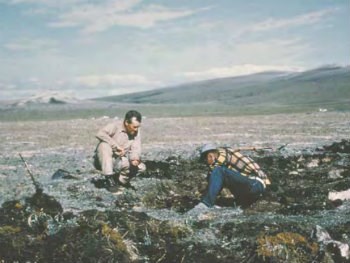
Photo courtesy of Haffenreffer Museum of Anthropology Giddings was born in Caldwell, Texas in 1909, but both his professional and personal passion soon drew him to the land of the midnight sun. After earning his BS from the University of Alaska Fairbanks in 1931 and studying at the University of Arizona, he was hired as an anthropology professor by UAF in 1938. The following year, Froelich Rainey, a fellow professor, invited Giddings to join his summer excavation near the village of Point Hope, 150 miles north of the town of Kotzebue. The excavation uncovered the first remains of the Ipiutak civilization, a previously unstudied culture that carved intricate masks and figurines out of ivory two thousand years ago. The Ipiutak ruled over an extensive empire stretching from the Bering Straits to Point Barrow for nearly a thousand years. It was Giddings’ introduction to fieldwork and Arctic archeology, an experience he described as “more dramatic to me than the opening of Tut-ankh-amen’s tomb,” but it was his solo trip down the Kobuk River in search of wood samples the following summer that would ultimately define his career. The Search for Old TreesAt the University of Arizona, Giddings had studied under A. E. Douglass, the father of dendrochronology. Dendrochronology is the science of using tree rings to date a piece of wood, and therefore objects made from the wood. A tree’s growth rings vary from year to year as a result of environmental conditions. The better the weather, the larger the growth ring. Over time, a tree’s growth rings form a pattern that can be matched to the growth ring patterns of other trees in the area. When a tree is freshly cut, each growth ring can be matched to an exact year on the modern calendar. If a section of a known growth ring pattern matches the pattern in a piece of old wood, such as a piece of timber used in an old house, archeologists can date when the wood was cut and the house was built. Dendrochronology is invaluable as a way of dating historic artifacts and sites, especially in the years before radio carbon dating. Giddings, who was interested in the arrival of humans to Northwest Alaska and the development of the local Inupiaq culture, hoped that collecting wood cores from trees along the Kobuk River would allow archeologists to date when people first arrived in North America. 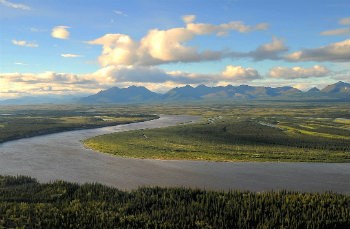
Maps of Alaska’s Interior were still more of rough sketches in the first half of the twentieth century. When Giddings’ embarked on his journey in July of 1940, his map showed a 50 mile wide blank space between the headwaters of the Kobuk River and the nearest town. Undeterred, he flew to the village of Allakaket on the Koyukuk River and set off on foot towards the Kobuk River with only a 40 pound pack, a compass and a rifle for hunting. Missionaries in Allakaket were so concerned that he would die in the wilderness that they sent a letter to the president of UAF begging him to launch an aerial search for his remains. For six days, Giddings battled stifling heat, rough terrain and unending assault from mosquitos before arriving on the banks of the Kobuk River. There he built a crude raft out of driftwood and floated down the Kobuk for three days before arriving at the fish camps of Henry Stocking and Roxy Douglas 20 miles from the village of Shungnak. Daisy Tickett, who was a young child when Giddings floated up to her family’s camp, later recalled Giddings’s remarkable arrival: “The arrival of Mr. Giddings..., I always thought it may have been July or August, but he arrived at the time we were in summer camp...His raft was remarkable in that it was very short and small and seems like it was constructed to sit on it by placing several pieces of wood. It was in the afternoon when we see a stranger in view on a raft. The stranger stopped in front of us and got off. So that was Louis Giddings who arrived.” With help from local residents, Giddings continued his trip down the Kobuk to the village of Kiana, stopping periodically to take tree cores and conduct rudimentary excavations. He returned the following year with a graduate student and hired eight local men to assist with more in-depth excavations, including the Onion Portage site. This was arguably his more important find, but he didn’t recognize its age or significance until much later. Following a stint in the military during World War II, Giddings returned to the Alaska where he spent another summer working on the Kobuk River. He then turned his attention to the coast and spent four seasons excavating at Norton Bay on the Seward Peninsula. At the site of Iyatayet, he uncovered a second previously unexplored Arctic culture, the Denbigh Flint Complex, which dated to 4,000 BCE. 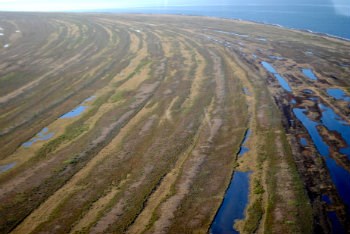
Throughout the 50s, Giddings established himself as an expert in Arctic prehistory and earned his PhD from the University of Pennsylvania, but it was the excavation of the summer of 1958 that truly set him apart from his peers. That summer, with the help of Almond Downey, a native of the village of Noatak, Giddings left Kotzebue in search of old beach ridges. Beach ridges form when the prevailing winds and ocean current cause big sediment dumps along a shoreline. Eventually, the sediment grows high enough that waves no longer wash over it and a new beach is formed. Over thousands of years, a series of ridges form, stretching out into the ocean with the oldest beaches now miles away from the water. Coastal people who rely on the ocean for food and transportation will choose to live as close to the water as they can – waterfront property has always been the most valuable real estate. This means the remains of the most recent culture will be found on the beach ridge closest to the ocean while older cultures will be found on beach ridges further back. The further a culture is from the ocean, the older it is. Giddings hoped to find a series of beach ridges old enough to have been used by all the different Arctic civilizations, allowing archeologists to firmly date them in relation to each other. Downey, who worked with Giddings for two decades, guided the crew across the Kotzebue Sound to the windswept shores of Cape Krusenstern, just south of the Krusenstern Lagoon. Here, Giddings discovered a series of 114 parallel beach ridges stretching inland for nearly three miles. Over the next five years, excavations uncovered the remains of 200 generations of people who had hunted and fished along the shores of Cape Krusenstern. Every known Arctic culture plus several new ones were represented in the beach ridges’ 6,000 year history. The Cape Krusenstern beach ridges were a remarkable find, one that allowed Giddings to show when different cultures existed in relation to others, but using beach ridges as dating method was unorthodox. Skeptics argued that there was no proof that every group of people would live on the beach ridge closest to the water. Giddings needed to find a site that matched the sequence of cultures found on the beach ridges, but stacked one on top of other. He needed to dig deep. 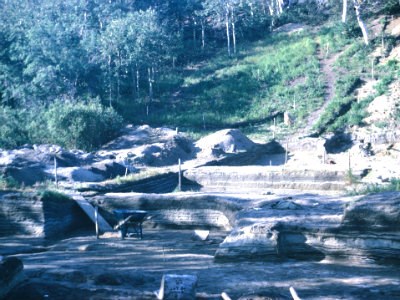
NPS Photo In July 1961, Giddings took a break from the excavations at Cape Krusenstern to return to Onion Portage on the Kobuk River. During his first visit, he had abandoned the site after excavating just four recent house pits, but he had always thought that there was more to be found. Twenty years later, he returned to Onion Portage to see what he had missed. The answer was… a lot. Onion Portage would turn out to be one of the oldest and best dated sites in not just the Arctic, but all of North America. It would be the most significant find in Giddings’ long and illustrious career. When Giddings first arrived on the Kobuk, local villagers told him that they would gather at Onion Portage, named for the wild onions that grow along the banks, to wait for the caribou to arrive on their yearly migration across the Brooks Range. They would wait until the caribou were crossing the river, then shoot them, a method known as intercept hunting. As Giddings began to dig beneath the floor of his previously excavated house pit, it was soon apparent that its inhabitants were not the first people to recognize the strategic position of Onion Portage. It was exactly the site that Giddings had been looking for. Giddings returned to Onion Portage in 1964 to continue excavations. As his crew worked, it quickly became apparent that people from cultures along the coast and new, inland cultures had been coming here to hunt for thousands of years. Ultimately, the excavation found evidence of nine different cultural groups dating back 10,000 years at Onion Portage. It is one of the best-dated sites in all of North America, and the most significant find in Arctic archeology. Louis Giddings died as a result of complications from a car crash in December, 1964. During his three decades of work in Northwest Alaska he greatly expanded the understanding of human occupation in the Arctic. His passion and dedication inspired a generation of future archeologist who continued his work in what is now Cape Krusenstern National Monument and Kobuk Valley National Park. |
Last updated: April 27, 2023
